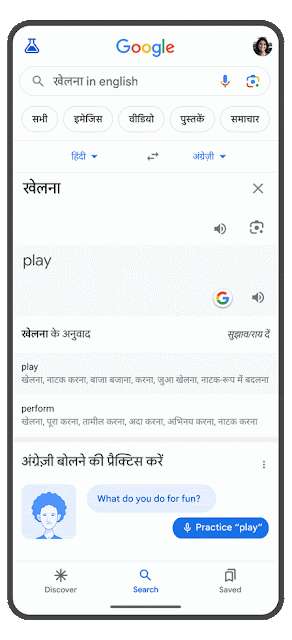

Google has announced a new feature of Google Search that helps people practise speaking and improve their language skills.
Within the next few days, Android users in Argentina, Colombia, India (Hindi), Indonesia, Mexico, and Venezuela can get even more language support from Google through interactive speaking practice in English — expanding to more countries and languages in the future.
Google Search is already a valuable tool for language learners, providing translations, definitions, and other resources to improve vocabulary. Now, learners translating to or from English on their Android phones will find a new English-speaking practice experience with personalized feedback.
Many learners cite a lack of opportunity to practice speaking actively and receiving actionable feedback as a barrier to learning.

A new feature of Google Search allows learners to practice speaking words in context. Learners are presented with real-life prompts and then form their own spoken answers using a provided vocabulary word. They engage in practice sessions of 3-5 minutes, getting personalised feedback and the option to sign up for daily reminders to keep practicing. With only a smartphone and some quality time, learners can practice at their own pace, anytime, anywhere.
Designed to be used alongside other learning services and resources, like personal tutoring, mobile apps, and classes, the new speaking practice feature on Google Search is another tool to assist learners on their journey.
Judit Kormos, Professor at Lancaster University said, “We have partnered with linguists, teachers, and ESL/EFL pedagogical experts to create a speaking practice experience that is effective and motivating. Learners practice vocabulary in authentic contexts, and material is repeated over dynamic intervals to increase retention — approaches that are known to be effective in helping learners become confident speakers.”

Every learner is different, so delivering personalised feedback in real time is a key part of effective practice. Responses are analysed to provide helpful, real-time suggestions and corrections. The system gives semantic feedback, indicating whether their response was relevant to the question and may be understood by a conversation partner. Grammar feedback provides insights into possible grammatical improvements, and a set of example answers at varying levels of language complexity give concrete suggestions for alternative ways to respond in this context.
Among the new technologies developed, contextual translation provides the ability to translate individual words and phrases in context. During practice sessions, learners can tap on any word they don’t understand to see the translation of that word considering its context. This is a difficult technical task, but a novel deep learning model, Deep Aligner, has been developed to enable accurate word alignment, greatly improving the quality of translations.
To enable grammar feedback for accented spoken language, research teams adapted grammar correction models for written text to work on automatic speech recognition (ASR) transcriptions, specifically for the case of accented speech. The model significantly increased the recall of grammar problems in spoken language.







Comments